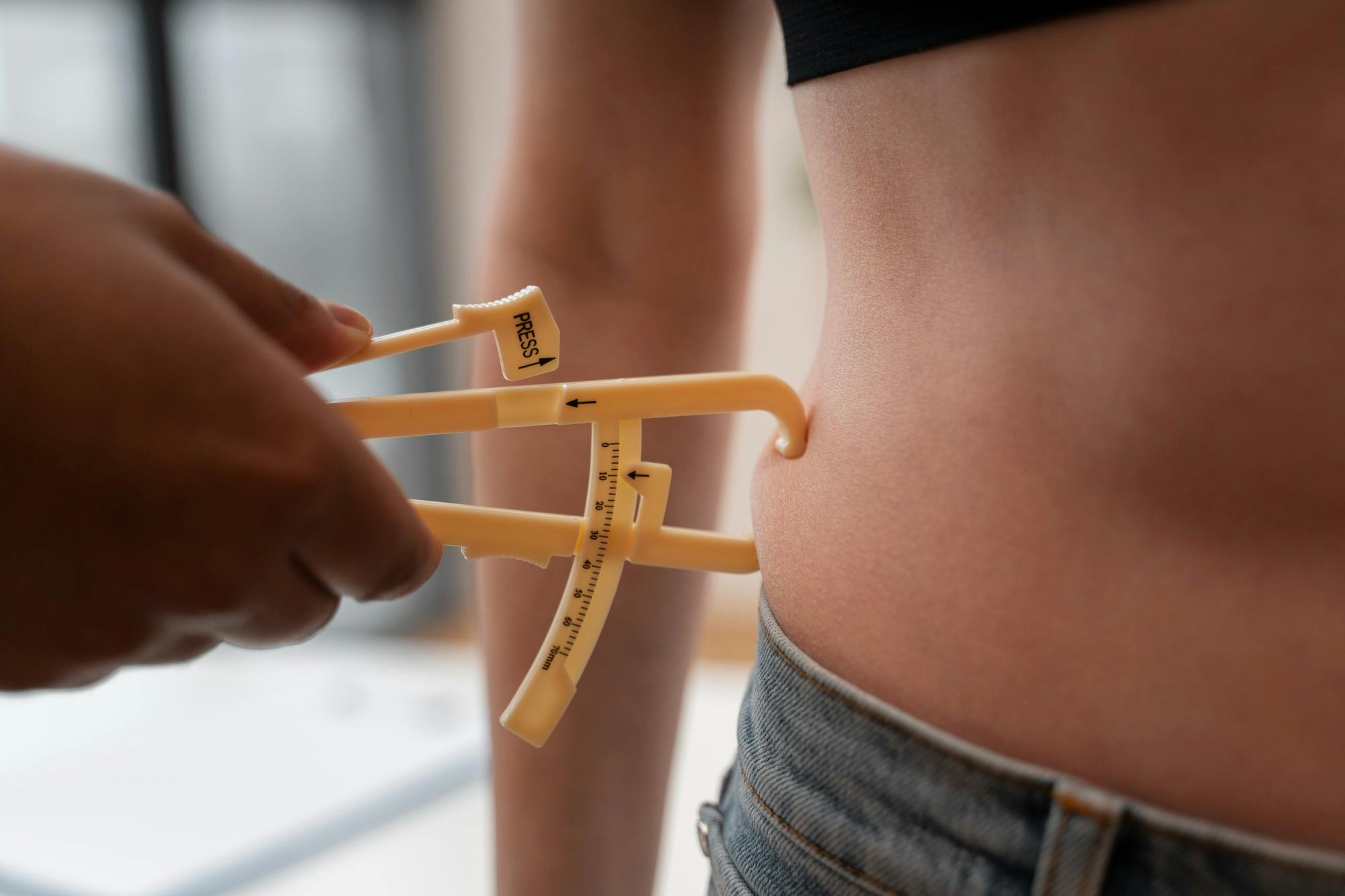Waist-to-Hip Ratio Calculator: What Your Body Shape Says About Your Health
By Dr. Jossy Onwude, MD
Reviewed by Kenya Bass, PA-C
Published Jun 10, 2025
9 min read

Your body shape can tell you a lot more than just how your clothes fit. It can give you valuable insights into your health, especially your risk for things like heart disease, diabetes, and metabolic issues. One of the best ways to measure this is with something called the waist-to-hip ratio (WHR).
If you’ve only ever used a scale or calculated your Body Mass Index (BMI), you might be missing a bigger piece of the puzzle. WHR goes beyond weight and height. It looks at where you store fat, and that matters a lot when it comes to your long-term health.
In this article, we’ll walk you through how to use our free waist-to-hip ratio calculator, how to measure yourself correctly, what the numbers actually mean, and how you can improve your ratio over time. It’s simple, evidence-based, and something anyone can do at home.
Use the Free Waist-to-Hip Ratio Calculator
Using the calculator is easy. All you need is a soft measuring tape and about 60 seconds. You enter your waist measurement, your hip measurement, and your gender. That’s it. The calculator will then tell you your ratio and what it means for your health.
Here’s how to use it:
- Measure the smallest part of your waist (usually just above your belly button).
- Measure the widest part of your hips (usually around the buttocks).
- Enter both numbers into the calculator.
- Get your results instantly.
You’ll find out if your ratio falls into a low, moderate, or high-risk category. And don’t worry—we’ll explain exactly what each of those means.
How to Measure Your Waist and Hips Accurately
Measuring your waist and hips properly is important if you want accurate results. The good news is that it’s very simple to do.
To measure your waist, stand up straight and wrap the measuring tape around your torso just above your belly button. This is usually the narrowest part of your waist. Don’t suck in your stomach. Just breathe normally and make sure the tape is snug but not tight.

To measure your hips, find the widest part of your lower body. This is usually across your buttocks and the top of your thighs. Again, make sure the tape is level and snug, but not digging into your skin.
Take each measurement twice to be sure. Use inches or centimeters, but be consistent. And always do this while standing up.
What Your Waist-to-Hip Ratio Means
Your waist-to-hip ratio tells you how fat is distributed in your body. People who carry more fat around their waist ("apple-shaped") are at a higher risk for chronic diseases than those who carry it around their hips and thighs ("pear-shaped").
Here’s how to understand your result:
For Women:
- Low risk: 0.80 or lower
- Moderate risk: 0.81 to 0.85
- High risk: 0.86 or higher
For Men:
- Low risk: 0.90 or lower
- Moderate risk: 0.91 to 0.99
- High risk: 1.0 or higher
For example, if you’re a woman and your waist is 30 inches and your hips are 40 inches, your WHR is 0.75 (30 ÷ 40 = 0.75), which falls in the low-risk category.
A high WHR means you’re more likely to have visceral fat – the type of fat that wraps around your organs and raises your risk of heart disease, diabetes, and even early death. A lower WHR usually means more fat is stored around the hips and thighs, which is considered less risky.
Waist-to-Hip Ratio vs. BMI: Which Is Better?
BMI, or Body Mass Index, is a common tool that uses your weight and height to estimate body fat. But it has some major limitations. It doesn’t tell you where your fat is stored or how much of your weight comes from muscle, bone, or fat.
That’s where WHR shines. It tells you how fat is distributed. A person with a normal BMI could still have a high WHR, especially if they carry extra weight around their middle. And that could mean a higher health risk.
In fact, research shows that waist-to-hip ratio is often a better predictor of health risks than BMI. One large study found that people with a normal BMI but a high WHR were more likely to die early than people with a higher BMI but a normal WHR.
So while BMI can still be useful, it doesn’t give the whole picture. WHR fills in the gaps.
Health Risks Associated with High Waist-to-Hip Ratio
If your waist-to-hip ratio is high, it could be a warning sign. This doesn’t mean something is wrong right now, but it does suggest that you might be at higher risk for certain health conditions in the future.
Here are some of the main risks:
- Heart disease: Fat around your waist puts stress on your heart and blood vessels.
- Type 2 diabetes: Belly fat is linked to insulin resistance.
- High blood pressure: A larger waist often means more pressure on your arteries.
- Metabolic syndrome: This is a cluster of problems including high blood sugar, cholesterol, and blood pressure.
- Stroke: A high WHR may increase stroke risk, especially in women.
- Sleep problems: People with central obesity are more likely to suffer from sleep apnea.
- Fertility issues: Especially in women, excess abdominal fat can disrupt hormones.
That’s why it’s so important to be aware of your WHR. Knowing your number helps you take steps to lower your risk.
How to Improve Your Waist-to-Hip Ratio

Improving your waist-to-hip ratio doesn’t mean you need to be skinny. It’s really about reducing the amount of fat around your waist and building a healthy lifestyle that supports long-term well-being.
Here are a few effective strategies:
1. Focus on whole foods. Cut back on processed snacks, sugary drinks, and refined carbs. Eat more vegetables, lean proteins, healthy fats, and whole grains. Fiber helps reduce belly fat over time.
2. Get moving. Exercise helps burn visceral fat, especially high-intensity interval training (HIIT) and strength training. Even walking every day makes a difference.
3. Manage stress. High stress raises cortisol levels, which can lead to belly fat. Try meditation, deep breathing, or just taking breaks to relax.
4. Prioritize sleep. Poor sleep can increase hunger and make it harder to lose weight. Aim for 7 to 9 hours per night.
5. Stay consistent. Small changes every day lead to big results over time. Don’t chase perfection—focus on progress.
There’s no magic fix, but with time, your waist-to-hip ratio can improve naturally.
Who Should Use the Waist-to-Hip Ratio Calculator?
This tool is great for just about anyone who wants a better picture of their health. It can be especially helpful for people who:
- Are curious about their body shape and health risk.
- Want more information than a BMI can offer.
- Are trying to lose weight and want to track progress.
- Have a family history of heart disease or diabetes.
However, WHR isn’t perfect for everyone. It might not be accurate for children, athletes, pregnant women, or people with certain medical conditions. And it should never replace medical advice from a doctor.
Limitations of the Waist-to-Hip Ratio
As helpful as it is, the waist-to-hip ratio isn’t a perfect tool. It has a few limitations you should know about.
First, it can be affected by how you measure. If the tape isn’t in the right spot or you’re not standing up straight, your results might be off. Taking measurements at different times of day can also make a small difference.
Second, WHR doesn’t account for muscle mass or body composition. A very muscular person might have a higher WHR, but that doesn’t mean they’re unhealthy.
Finally, this ratio is just one piece of the puzzle. It’s best used alongside other health markers like blood pressure, cholesterol, and glucose levels.
Final Thoughts: Know Your Shape, Know Your Risk
Your waist-to-hip ratio is more than just a number. It’s a simple, science-backed way to understand how your body stores fat and what that might mean for your future health. It can help you spot early signs of risk and make smart changes before problems start.
So grab a tape measure, try the calculator, and get to know your body a little better. Whether you’re trying to lose weight, stay healthy, or just feel more confident, this small step can make a big impact.
Remember, health isn’t about being a certain size. It’s about taking care of your body in a way that supports a long, vibrant life. And understanding your waist-to-hip ratio is a great place to start.
FAQ: High-Intent Questions on Perimenopause Fatigue
1. Why do I feel overwhelmingly exhausted even after a full night's sleep during perimenopause?
Perimenopause fatigue often isn’t just one thing—it’s the result of fluctuating estrogen and progesterone disrupting your sleep cycle, neurotransmitter regulation (like serotonin and melatonin), and core body temperature control. This disruption leads to frequent awakenings—even if you sleep “enough”—resulting in a lingering day-long tiredness.
2. Could perimenopause fatigue be a sign of something other than menopause?
Yes. While hormone changes during perimenopause are a common cause, similar fatigue can also signal conditions like thyroid imbalance, anemia, depression, chronic infections, or cardiovascular issues. Red flags include chest pains, muscle weakness, shortness of breath, or mood disorders. If these symptoms accompany your fatigue, seek medical evaluation.
3. How long does perimenopause-related fatigue usually last?
It varies, but studies show around 46–50% of women experience fatigue during perimenopause, and it can persist through menopause. For many, energy improves once hormone levels stabilize after menopause, but without intervention, symptoms may continue for years.
4. Is perimenopause fatigue more than just being tired? How is it different from normal tiredness?
Absolutely. Unlike ordinary tiredness, perimenopausal fatigue is persistent and deeper—it’s described as being “worn out” even after rest, affecting concentration, motivation, and daily functioning for weeks on end.
5. Can hormone therapy (HRT) specifically improve fatigue?
Yes, hormone therapy (also known as menopause hormone therapy) can significantly reduce fatigue by improving sleep continuity and reducing night sweats, which often disrupt rest. Many women report feeling notably more energized once HRT controls these symptoms.
6. What non-hormonal strategies improve energy during perimenopause?
Beyond HRT, several lifestyle and therapeutic approaches can increase energy:
- Improve sleep hygiene: Maintain consistent sleep routines and create a cool, dark bedroom environment.
- Stress reduction: Techniques such as meditation and deep breathing help manage cortisol levels that aggravate fatigue.
- Physical activity: Regular exercise—especially routines that combine cardio and strength training—supports energy and hormone balance.
- Medical assessment: Evaluate for other contributors like thyroid or iron issues, mental health conditions, or insulin resistance.
7. When should I talk to my doctor about fatigue during perimenopause?
Seek help if fatigue is severe, chronic, or disrupting your daily life. It’s especially important if it comes with concerning signs, such as irregular heartbeat, chest pain, muscle weakness, breathlessness, or severe mood changes. A healthcare provider can distinguish perimenopausal causes from other serious conditions.
8. Why is perimenopause fatigue often mistaken for depression or burnout?
The symptoms overlap: low energy, poor sleep, mood swings, and reduced concentration. But hormonal shifts during perimenopause are common culprits. Experts caution that mislabeling perimenopausal fatigue as purely psychological may delay effective treatment, such as HRT or lifestyle changes
Share this article

Magnesium for Weight Loss: Benefits, Risks, and What Science Really Says
Dr. Jossy Onwude, MD
Sep 29, 20259 min read

Mounjaro® Sulfur Burps Explained: Causes, Symptoms, and Science-Backed Remedies
Dr. Priyali Singh, MD
Sep 25, 202511 min read

Low Sodium Diet: Simple Guidelines, Food Lists, and Tips for Better Health
Lilian E.
Sep 30, 202512 min read

Best-in-class care is a click away
Find everything and everyone you need to reach your metabolic health goals, in one place. It all makes sense with Meto.
Join Meto